I'm flying off to Phoenix, AZ tonight then driving up to Flagstaff so our group can meet with the equipment outfitter in the morning and get set up for two weeks in the Grand Canyon. We launch on December 19th with hopes that Christo will not cover it or "recontextualize" the canyon in any way, and our group can experience the canyon in it's (mostly) natural beauty and enjoy something that stands on it's own as a work of art.
The week of January 3rd will be spent in Colorado editing photos and revisiting notes from the trip.
By the 8th, I should have internet access again and will post some initial photos.
I expect this trip to provide enough source material for the entire Spring semester.
The semester starts late enough so I'll have time to collaborate with alternative photography artists in a few places around Durango and New Mexico before returning to teach.
Sunday, December 19, 2010
Saturday, December 11, 2010
On Top Of The White Whale
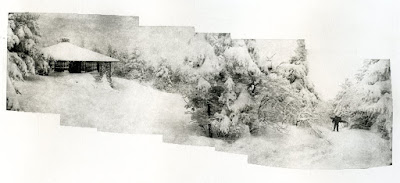
I've been working on this one since last Spring and finally have this difficult image balanced the way I like it.
The challenge has been to keep some tone in the sky and snow without just dropping the contrast.
If this was a single shot in which all elements were static I could use a modern version of an HDR image.
Since it is a panoramic, made while the figure was moving (and some wind was threatening to move the rest of the environment), I had to go old-school HDR by doing some subtle burning and dodging as well as a bit of contrast adjustment.
The Grayscale Gradient Test was an integral part of it too, since it is teaching me the limits of the KM73 polymergravure plates.
Friday, December 10, 2010
Tuesday, December 7, 2010
grayscale test for photo polymer gravure
Here is a grayscale from 100% - 0% black on top, and a grayscale from 80% - 20% black on the bottom.
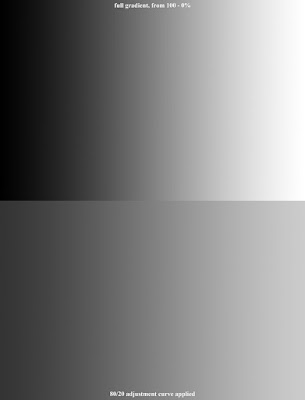
Below are two proofs from a KM73 plate using the above image on a transparency for exposure.
Each proof is wiped slightly different.
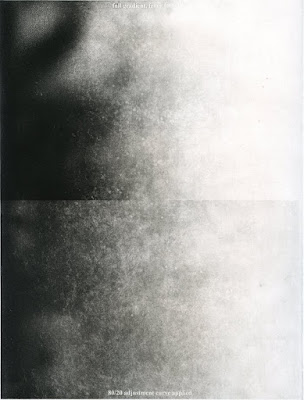
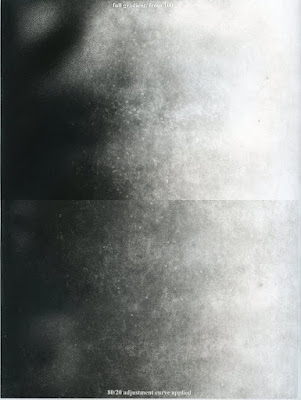
It gives me a good idea of where the values and information drop out completely, and how smooth a transition can be achieved. Using this twin scale, I have to figure out how to eliminate the white spots. There are two types. One set in which it seems that the black area washes out. I don't know if it's residual moisture left in the transparency or if there is some other gas that is not escaping. The individually scattered white dots are a bit of a mystery to me. I'll have to re-read Jon Lybrook's page on photo polymergravure again.
-----------------------------------------------------------------
The image below is a curve test for the transparency: no adjustment to the image in the top-left spot; the 80/20 adjustment I've been using in the top-right spot, and some variations in the lower two spots.
I'm still a fan of the 80/20 curve, but it looks like the 85/15 curve would be useful for adding some contrast to very flat image that would be a bit different than just adding it in Photoshop.
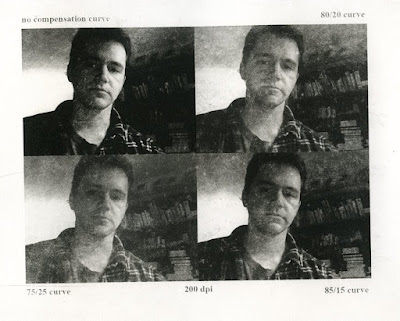
same plate. the only difference is the ink wiping strategy. It's more of a feel thing. I do this to see how I'll edition an image.
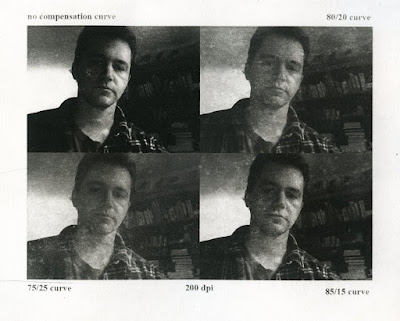
This is the file I used to make the transparency/positive for the plate above.
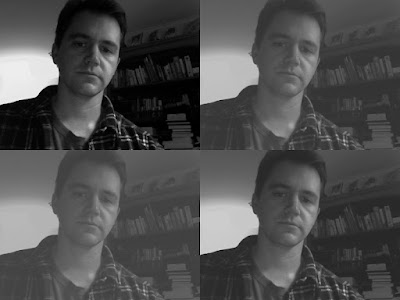
I used a simple 80/20 curve applied over the entire image to see if I could predict what the plate would do.
This is the result.
I'm surprised by the amount of information left in the top left image. That would tell me that the dropout is somewhat higher than 80% black, therefore I can pay attention to the shadows a bit more and see what details don't have to be sacrificed.
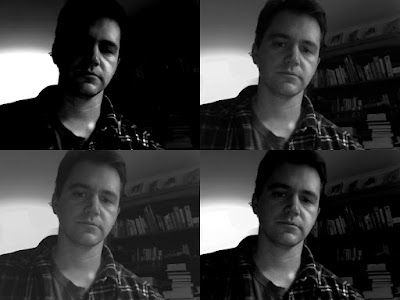

Below are two proofs from a KM73 plate using the above image on a transparency for exposure.
Each proof is wiped slightly different.


It gives me a good idea of where the values and information drop out completely, and how smooth a transition can be achieved. Using this twin scale, I have to figure out how to eliminate the white spots. There are two types. One set in which it seems that the black area washes out. I don't know if it's residual moisture left in the transparency or if there is some other gas that is not escaping. The individually scattered white dots are a bit of a mystery to me. I'll have to re-read Jon Lybrook's page on photo polymergravure again.
-----------------------------------------------------------------
The image below is a curve test for the transparency: no adjustment to the image in the top-left spot; the 80/20 adjustment I've been using in the top-right spot, and some variations in the lower two spots.
I'm still a fan of the 80/20 curve, but it looks like the 85/15 curve would be useful for adding some contrast to very flat image that would be a bit different than just adding it in Photoshop.

same plate. the only difference is the ink wiping strategy. It's more of a feel thing. I do this to see how I'll edition an image.

This is the file I used to make the transparency/positive for the plate above.

I used a simple 80/20 curve applied over the entire image to see if I could predict what the plate would do.
This is the result.
I'm surprised by the amount of information left in the top left image. That would tell me that the dropout is somewhat higher than 80% black, therefore I can pay attention to the shadows a bit more and see what details don't have to be sacrificed.

Thursday, December 2, 2010
Subscribe to:
Comments (Atom)
